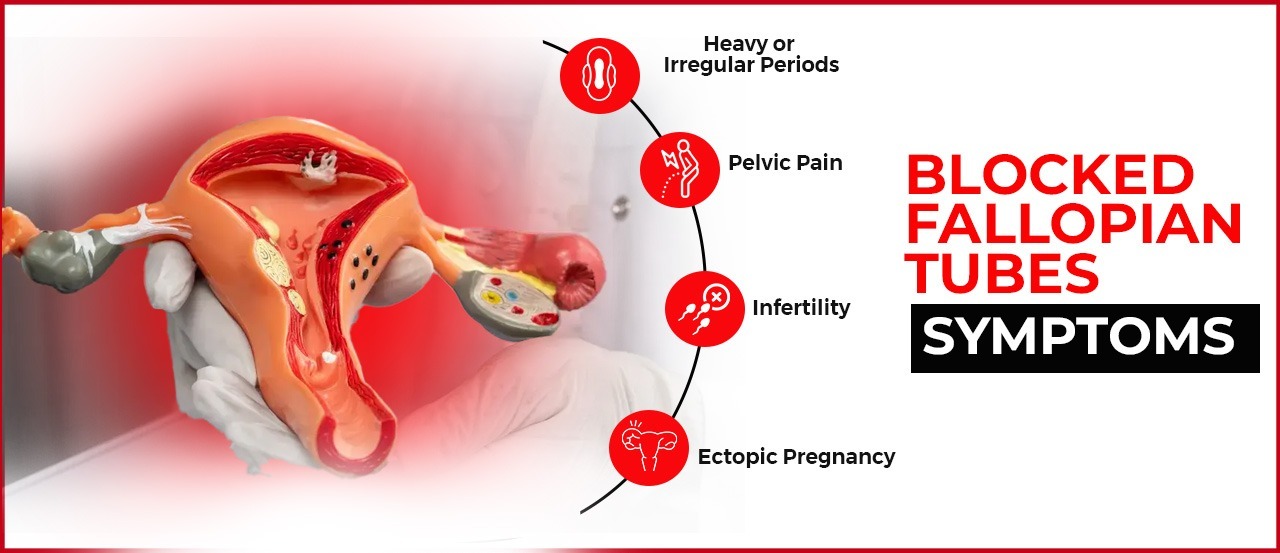Blocked Fallopian Tubes: Causes, Symptoms & Treatment

Introduction
For many women struggling to conceive, the reason often lies hidden in a part of the body they’ve never thought much about—the fallopian tubes. In India, blocked fallopian tubes account for nearly 25–35% of female infertility cases, making it one of the most common causes of difficulty in getting pregnant. What’s more, most women don’t even know they have this condition until they face months or years of unsuccessful attempts. Infections like pelvic inflammatory disease and genital tuberculosis—which alone affects up to 15% of infertile women in India—are leading culprits. The good news? Thanks to modern fertility treatments like In Vitro Fertilization (IVF), pregnancy is still possible even if both tubes are completely blocked. At Imprimis IVF, we help women overcome this challenge with advanced technology, experienced specialists, and success rates that bring hope back into the journey of parenthood.
Understanding Fallopian Tubes & Their Role in Fertility
Your fallopian tubes may be tiny—about 10–12 cm long—but they play a massive role in making pregnancy possible. The fallopian tubes are thin and delicate structures that link the ovaries with the uterus, serving as the passage where the egg and sperm come together. In a normal cycle, once an ovary releases an egg, the fallopian tube gently sweeps it in and provides the perfect environment for fertilization. If sperm reaches the egg here, the resulting embryo travels down the tube to the uterus, where it can implant and grow.
Studies show that over one-third of infertility cases worldwide are linked to problems in these tubes, and in India, the number is even higher due to factors like pelvic infections and genital tuberculosis. The tubes’ lining is extremely delicate—any damage, scarring, or blockage can prevent sperm and egg from meeting, making natural conception very difficult or even impossible. In simple terms, healthy fallopian tubes play a crucial yet often overlooked role in fertility.
How Common is Tubal Blockage?
Blocked fallopian tubes are a major concern in India, accounting for nearly one-third of all infertility cases among women, with studies showing it contributes to about 25–35% of female infertility. Research from fertility clinics across the country shows that 1 in every 3 women facing difficulty in conceiving has some form of blockage or damage to the fallopian tubes.
It is particularly common in women who have a history of pelvic infections, abdominal or pelvic surgeries, or genital tuberculosis (TB). Genital TB alone is found in up to 15% of infertile women in India, a figure that is significantly higher than in Western countries where TB is rare.
The reasons for this higher prevalence in India include delayed diagnosis and treatment of infections, limited awareness about reproductive health, and less frequent preventive screening. Together, these factors make tubal blockage a major—yet often preventable—cause of infertility among Indian women.
Symptoms of Blocked Fallopian Tubes

A major difficulty with fallopian tube blockages is that many women experience little to no noticeable symptoms. In many cases, the first and only sign is difficulty conceiving despite trying for 12 months or more without success.
Some women may experience mild or chronic pelvic pain, which can be more noticeable during their periods or around ovulation. This pain is often linked to conditions like endometriosis or pelvic inflammatory disease, which are known causes of tubal damage.
Experiencing an ectopic pregnancy, where the fertilized egg remains in the fallopian tube instead of moving to the uterus, may indicate a possible tubal blockage. Around 2 out of every 100 pregnancies turn out to be ectopic, and women with damaged fallopian tubes face a higher risk.
Infections such as genital tuberculosis or sexually transmitted infections (STIs) may also cause unusual vaginal discharge, fever, or pelvic discomfort. However, many women never notice any warning signs until they undergo fertility testing, making timely diagnosis crucial.
Causes of Blocked Fallopian Tubes

Blocked fallopian tubes can develop due to several health conditions and life events, many of which can be prevented with timely medical care.
-
Infections (Pelvic Inflammatory Disease & STIs)
Pelvic Inflammatory Disease (PID) is a leading reason behind blocked tubes, and it often develops after untreated infections such as chlamydia or gonorrhea. Studies show that untreated STIs can increase the risk of tubal damage by up to 50%. In India, pelvic inflammatory disease is still common, largely because many women receive a late diagnosis or do not get timely treatment.
-
Genital Tuberculosis (India-Specific Cause)
Genital TB is a significant cause of tubal blockage in India, affecting up to 15% of infertile women.This condition often causes intense inflammation and permanent scarring in the reproductive system, particularly affecting the fallopian tubes.
-
Endometriosis
When tissue resembling the inner lining of the uterus develops outside it, it may lead to the formation of adhesions around the fallopian tubes. Endometriosis impacts nearly 1 in 10 women in their reproductive years and is a recognized factor behind tubal infertility.
-
Previous Pelvic or Abdominal Surgeries
Procedures such as appendix removal, fibroid surgery, or surgery for ectopic pregnancy may result in scar tissue that blocks the tubes.
-
Congenital Anomalies
In rare cases, women may be born with absent, underdeveloped, or malformed fallopian tubes.
-
Lifestyle & Untreated Infections
Poor reproductive health awareness, untreated infections, and lack of preventive screenings further increase the risk of tubal blockage in Indian women.
Diagnosis of Blocked Fallopian Tubes

Diagnosing tubal blockage involves specialized scans that help doctors determine if the fallopian tubes are open. At Imprimis IVF, we offer all modern diagnostic options to ensure accurate and timely results.
-
Hysterosalpingography (HSG)
HSG is a diagnostic test in which an X-ray and a contrast dye are used to examine the uterus and fallopian tubes. If the dye flows freely, the tubes are open; if not, a blockage is suspected. Studies show HSG has 80–90% accuracy in detecting blockages. The procedure takes about 15–20 minutes, and while some women feel mild cramping, it is generally well-tolerated. Cost in India typically ranges from ₹3,000–₹7,000.
-
Sonohysterography / HyCoSy
This is an ultrasound-based method that uses saline or foam instead of X-ray dye. It avoids radiation, is less uncomfortable, and provides similar accuracy to HSG. It is becoming popular in advanced IVF centers.
-
Diagnostic Laparoscopy
Laparoscopy is widely regarded as the most accurate method and involves a small surgical procedure performed under anesthesia. A tiny camera is inserted through the abdomen to view the tubes directly, and dye is injected to confirm if they are open. It can also treat minor adhesions during the same procedure. Costs range between ₹15,000–₹40,000 depending on the hospital.
Treatment of Blocked Fallopian Tubes
Blocked fallopian tubes are one of the few infertility problems where natural conception is almost impossible—because the egg and sperm cannot meet. In such cases, In Vitro Fertilization (IVF) is the most effective solution, as it bypasses the tubes entirely. In IVF, eggs are retrieved from the ovaries, combined with sperm in a laboratory, and the embryo is then transferred into the uterus, bypassing the blocked fallopian tubes altogether.
Here’s the simple step-by-step process:
- Ovarian Stimulation – Medicines help multiple eggs mature.
- Egg Retrieval – Eggs are collected through a short, painless procedure.
- Fertilization – The fertilization step takes place in the lab, where sperm meet the eggs to develop embryos.
- Embryo Transfer – In this step, a selected healthy embryo is gently transferred into the uterus to encourage implantation.
In India, IVF for tubal-factor infertility shows success rates of 50–60% per cycle in women under 35—often higher than for other causes of infertility, because the uterus is usually healthy.
While surgical tuboplasty (tube repair) was common earlier, studies show that IVF offers faster results, fewer risks, and higher pregnancy rates, especially for women over 30 or with severe damage.
IVF Success Rates for Tubal Blockages in India
When it comes to blocked fallopian tubes, IVF success rates are often higher than average because the uterus is usually healthy and ready for implantation. In India, women under 35 have a success rate of around 55–60% per IVF cycle for tubal-factor infertility. For women aged 35–40, the success rate is about 40–45%, while those above 40 can expect around 20–25% per cycle due to reduced egg quality.
One of the biggest advantages is the cumulative success over multiple cycles—research shows that 3 IVF attempts can give up to 80–85% total pregnancy chances in women under 35 with tubal issues.
Compared to other causes like low ovarian reserve or severe male infertility, tubal infertility generally responds better to IVF, as the ovaries and sperm quality may still be normal. This means that, with proper treatment planning, most women with blocked tubes can achieve pregnancy within a year of starting IVF.
Cost of IVF for Blocked Tubes in India & at Imprimis IVF
Across India, the cost of one IVF cycle for women with blocked tubes usually falls between ₹1–1.5 lakh, with variations based on location, clinic standards, and the type of technology applied. The total expense includes fertility medications (which can make up 30–40% of the cost), lab procedures, and any advanced techniques like ICSI (Intracytoplasmic Sperm Injection) or embryo freezing.
At Imprimis IVF, the focus is on making treatment both affordable and transparent. Packages are tailored to the patient’s needs, and EMI options are available to ease financial stress. Special plans for multiple cycles can also help improve success chances while reducing overall cost.
Why Choose Imprimis for Blocked Fallopian Tubes
At Imprimis IVF, tubal-factor infertility is treated with precision and care. The clinic uses advanced diagnostic tools like HSG, HyCoSy, and laparoscopy to ensure accurate detection of blocked tubes. With a team experienced in hundreds of successful tubal-factor IVF cases, patients benefit from protocols tailored to bypass the tubes entirely.
Our advanced embryology lab features cutting-edge incubators, purified air systems, and time-lapse imaging, all designed to improve fertilization and embryo implantation success. On average, success rates for tubal infertility cases here exceed national IVF averages, especially for women under 35.
Conclusion
With expert care, advanced technology, and high success rates, Imprimis IVF offers one of the best chances for women with blocked tubes to achieve a healthy pregnancy.

